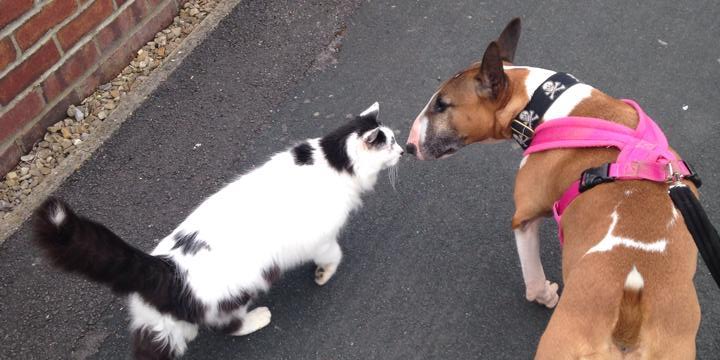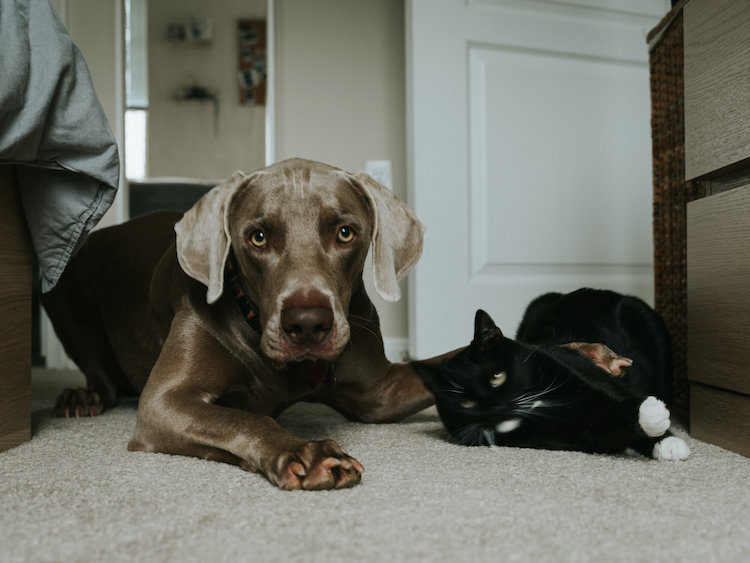
In 2019, Cats Protection rehomed 41,000 cats and the Dogs Trust rehomed 11,790 dogs. That’s a lot of pets potentially moving into the home of another! Each pet is an individual, so how can we make the transition easier for them?
Introducing a dog to a cat household (and vice versa)
Domestic cats are a social species, some selectively depending on factors such as environment and early social experience, and they can form strong attachments to their caregivers. If a cat is content, they will display their normal behaviours such as grooming, hunting and play. This can be disrupted when changes occur, because cats are especially vulnerable to acute stress and can quickly lose their appetite. If this becomes chronic, it can cause not only behavioural issues, but can cause urinary and digestive issues. Seek vet advice if you notice a change in digestive or toileting behaviours.
Plan ahead
Begin adapting to the environment gradually, so your current pet has a chance to get used to the new arrangements. Have a look at your home and think like a cat, get to know them as a species and similarly for the dog too. By learning how they communicate and behave, and what their needs are as an individual, you’ll be able to see what changes should be made and where making the introduction to the home smoother. Keep your expectations realistic, things don’t always go according to plan and the new pet may not be right for your situation.
Cats need to have quiet places to be alone or hide in and high observation areas. They also need to eat and drink and sleep with a sense of safety, so place food and water stations separately and in a location where they can view the home as they eat or drink. Cats also need to be able to groom and go to the loo in peace. Allocate a space, maybe upstairs or a different room, that is specifically for your cat. If they are indoor cats, they need plenty of choice for toileting, with their preferred type of litter substrate. They also need a scratching surface to maintain nail health and scent transfer.
“Reward calm behaviours from the dog and cat”
Cats are often tactile – touchy feely – either with each other or with us, and need to be able to rub to greet or brush against something to spread their scent on. This is really important for them as it’s how they feel content and secure because of the familiar odours there. Scent is so important to cats, as well as dogs.
If your cat uses a cat flap, consider how they can still do so without having to go past where your dog is likely to be spending a lot of time, or place one elsewhere and spend time helping them with this change. Then think further ahead to how you’d slowly introduce them being together, if appropriate, by using stair gates, and what types of toys and food dispensers you can use to add positive associations for both species. Have all this in place so your pet can adapt to them.
Dogs also need hiding places and to be able to eat, drink, rest and groom without interference. They also like to have several resting locations and are often more active in the evenings when younger, much like cats. Some dogs look to their humans for reassurance, security and comfort, so consider how you also meet these needs as well as their physical and mental needs and that of the other pets present.
Have a think about their temperaments and characteristics; would they cope with a new pet?
Other Adaptions - Scent Transfers
Introduce them to each other before you bring the dog home by giving the cat something that smells of them, and giving the dog something that smells of the cat, like a blanket or toy to sniff. Repeat daily and continue for a couple of weeks after they are in the home. Check for signs of stress when sniffing these articles – it’s not a good sign if they freak out after smelling it.
Be mindful to not allow chasing, as a lot of dogs find this rewarding and a lot of cats don’t. Undoubtedly the new pet will be excited or even stressed, and may have experienced emotional or physical trauma so might be feeling vulnerable. Ensure your cat remains safely tucked away, while your dog explores the places where they will be allowed in the home, calmly and ideally on lead, and reward calm behaviours with calm praise. Show them where their water station is, their rest locations and their toilet locations. If other cats enter the garden, ensure they aren’t present whenever you let the dog out there. It will help to teach your dog to pay you attention as a behaviour.

Train your dog at home
If you’re introducing a cat to a home with an established dog, the same applies. Have the dog safely out of reach, bring your cat inside in their carrier and take them to their safe zone, then sit with them while they decompress. Ensure they can’t escape and risk accidentally meeting the dog. Allow them the choice to exit the carrier and explore (leave it out as a safe space for them), toilet and take in their new surroundings. Be calm and let them come to you.

Spend quality time with your dog too, they need to know they are still important to you. Supervise all movements within the house, keeping the dog on lead, or on a walk or behind a barrier to allow the cat to safely explore their surroundings in the first few days.
Avoid having everyone over to meet the dog or cat for at least a couple weeks, allow them time to decompress especially if they are skittish or anxious. Newly adopted pets can take weeks to settle into their new environment.
Your behaviour affect theirs
Be mindful of being over excited around your new pet, even more so if you have young children. You’ll need to explain in the weeks ahead how to behave appropriately around dogs, respect their personal space, and teach them that if the dog or cat is resting or asleep to leave them alone. Not all pets enjoy being touched.
Go slowly, no need to rush
If they are coping well and have settled in, it might be time to introduce them. This should only be done under close supervision behind a baby gate or a clear perspex sheet across a doorway, with the dog on lead to prevent chasing and ensure your cat has an escape route. Reward calm behaviours from the dog and cat, allowing your cat to choose to hide or go to their core area. Introductions should not be done with your cat confined or restrained and should always be at their level of emotional comfort.
If there are any signs that your dog is excited, keep them separated and work more on the calm behaviours. Your cat needs to always feel safe and your dog always needs to remain calm to allow predictability for your cat and for the dog too. Always reward calm behaviours around your cat.
Behaviour Changes
If your cat grooms less, eats less, seeks you out less, has toileting issues or yowls, you’ll need to take another look at the home set up and the quality of your interactions with them. Are you still playing with them, talking to them, cuddling them or grooming them if they enjoy this? Can you do this for longer periods and have someone sit with the dog if they get upset without you? If your cat is aggressive towards the dog even if the dog is calm around them, you’ll need help.
If your dog is vocalising, this can upset your cat. Set up the environment the dog exists in to prevent this, or manage them so they are more settled. Is your dog panting excessively, yawning, vocalising, or unable to take food with the cat present? If so, lower the intensity of the situation by encouraging your dog to their safe space or go to the garden for a sniff around.
When and who to ask for help
If problems start or persist, seek advice from your vet and a suitably qualified expert, such as a member of the Association for Pet Behaviour Counsellors (APBC), a Certified Clinical Animal Behaviourist (CCAB) or a member of the International Association of Animal Behaviour Consultants (IAABC).
Our Expert
I am happy to support anyone needing help with their dog – cat relationships and can provide behaviour consultations online if you aren’t local to Bristol. I’m a member of APBC and IAABC, I’m working towards CCAB with 16 years of experience, and am also a behaviourist for a worldwide dog welfare charity.
For more information: www.katiescottdyer.com
